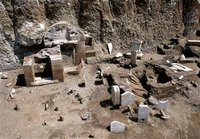 Three years ago, while building a parking lot of all things, workers at the Vatican unearthed an unknown ancient burial ground. AP reports that Vatican visitors will soon be able to descend into the burial ground for an untouched look at life–or more importantly, death–for middle class citizens living under Roman rule from Augustus, beginning in 23 A.D., to Constantine, in the 4th century. Hailed as Vatican City’s version of Pompeii, the necropolis holds everything from funeral urns to engravings, sculptures and sarcophagi.
Three years ago, while building a parking lot of all things, workers at the Vatican unearthed an unknown ancient burial ground. AP reports that Vatican visitors will soon be able to descend into the burial ground for an untouched look at life–or more importantly, death–for middle class citizens living under Roman rule from Augustus, beginning in 23 A.D., to Constantine, in the 4th century. Hailed as Vatican City’s version of Pompeii, the necropolis holds everything from funeral urns to engravings, sculptures and sarcophagi.
But in a city where tourists can stroll along the Tiber to visit the mausoleums of Hadrian and Augustus, what makes this new underworld so notable? According to Paolo Liverani, a former Vatican Museums official, it helps “document the middle class, which usually escapes us. You don’t construct history with only generals and kings.” The artifacts also shed light on the subject of religion in a period when Christians were highly persecuted.
Thinking of adding the necropolis to your next Vatican visit? As of this week, you can, but be sure to plan ahead. All visitors must write to the Vatican Museum for permission before being allowed to tour the grounds. Tours will be conducted in groups of 25 or less, on Fridays and Saturdays. The Vatican plans to expand visiting days based on popularity of the site. — Shauna Maher

